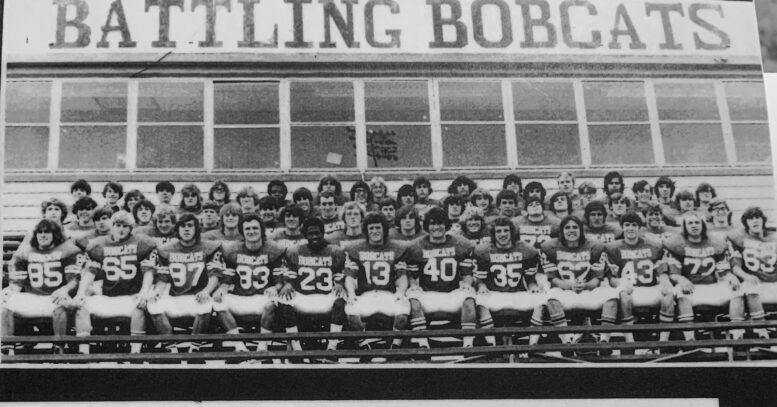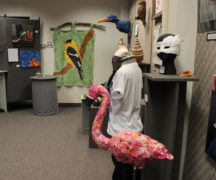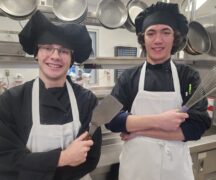By JULIE CARLE
BG Independent News
Fifty years ago this fall, a football team at Bowling Green High School did something no other Bobcat football team had done before. They finished the regular season with a perfect 10-0 record.
Amazingly in the 50 years since then, the 10-0 record has stood the test of time over the school’s approximate 125-year history. There were two other teams in the 1920s that were undefeated with shorter seasons.
The 1973 season was capped off when they won the Great Lakes League and the Great Northern Conference Championship, earned a spot in the Class AAA state playoffs, and were ranked fifth in the final state poll. In the state semi-final game, they faced defending state champion Warren Western Reserve and lost 30-0.
Many members of the team and the coaches, led by head coach Stu Stearns, will attend Friday night’s Bobcat home football game where they will celebrate the 50th anniversary and be introduced at halftime as 2023 inductees into the Bowling Green High School Athletic Hall of Fame. The team is inducted as a whole, and Stearns is honored as head football coach for eight years, as well as other coaching and athletic director duties during his 32-year teaching career at the high school.
The significance of the 10-0 record has stayed with the players and coaches for five decades. The team came off a 2 and 8 season the year before, to a season in which they shut out four of their opponents and outscored the other teams 313 to 74. Led by senior co-captains quarterback Craig Cheetwood and fullback/linebacker Rick Dyer, the team developed into a force to be reckoned with on both sides of the ball.
The offense was explosive and the defense solid, Dyer recalled. They averaged over 31 points per game and gave up an average of 7.4 points per game. Eleven players were named to the all-league first and second teams, but many more played key roles. From the seniors to the underclassmen, everyone contributed. Their fifth-place ranking put them among Ohio’s largest schools in the final state poll.
Though they can still recall many of the more memorable moments of that season, some of the specifics have blurred over time. Instead, the lasting memories are more about the powerful bonds established among the players and coaches during and beyond that magical year.
One for all and all for one
“To have success in high school, you’ve got to have all the classes come together and feel like they are part of the team,” said Dyer.
“Everybody contributed,” said Doug Hoskinson, a senior center and defensive end. “I think the seniors provided a bit of motivation to the lower classmen, but at the same time, we welcomed their input and their enthusiasm. Everybody was motivated and everybody worked together to motivate the team.”
“It was a one-for-all and all-for-one attitude,” Cheetwood said.
Coach Stearns, who is now 88 years old, said, “We had a good nucleus. Co-captains Craig Cheetwood and Rick Dyer did a great job during the offseason helping to get the kids ready.”
Stearns also sat down with each team member to ask about their expectations and what they wanted to do so they were ready to play by the time summer conditioning, two-a-days and the season came around.
“The kids were very united. They worked together and with the coaching staff. I knew we were going to be pretty decent. It was a matter of whether we would have injuries or things that would interfere with the season,” he recalled.
Brad Stearns, who was a junior on the team, said one of his favorite bonding memories was the night before the first game of the season when the team had dinner together at Ponderosa and then went to see the movie, “Live and Let Die.”
“That kind of group activity set the stage for a close, team-like effort,” he said.
That bond also led to everyone wanting to play their best. “I remember (Coach) Hub (Reed) asking me on the way to a game if I was nervous. I remember saying, ‘Yeah, I’m nervous. I don’t want to make a mistake or let my teammates down,’” said the former defensive back and fullback
“This celebration is about everybody,” said John Reynolds, who played defensive back on the team. “But the seniors on that team from seventh grade until our senior year lost only one game for all those years when we played together.”
“You were dominant all through middle school,” Brad Stearns pointed out.
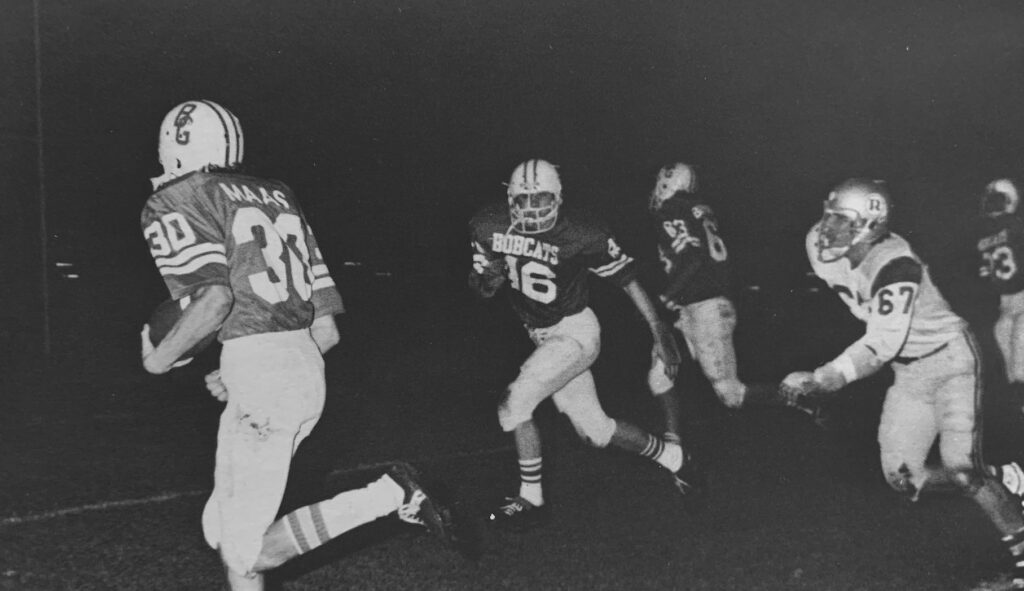
“But it doesn’t happen without you and Dicky (Maas) and (John) Titus,” Reynolds told him. “Do you remember the first time that Dicky broke loose? He was a junior tailback. We got to game day, and Dicky Maas was untested. The first time you broke loose and ran for 60 yards…oh yeah!”
When asked if they knew their potential going into the season, Andy Jackson, senior split end and safety, said, “I don’t think we knew it was going to happen like that, not after ’72” and the 2-8 record that year.
“I kind of think the coaches knew our potential,” said John Titus, junior tight end and defensive end.
Brad Stearns confirmed that from “spying on some of those coaches’ meetings. I’ll tell you; they knew the potential.”

Players and coaches had talent
Coach Stearns, along with John Quinn, P.J. Nyitray, Hub Reed and Bob Lotz knew the team had talent. “I told the kids If you come out here and work hard, we can be in and out of here” in an hour and a half at their practices, Stearns said. And they did. “They worked hard practicing the things that we wanted to cover. Everything went together really well. It was one of those years that you look back and realize everything kind of melded together.”
According to Reynolds, Coach Stearns was the “master chef,” but the coaching staff “might have been better than our team, quite honestly.”
“We give credit to the coaches. They figured out who should be where and who should do what,” Cheetwood said. Nyitray was a secret weapon as offensive coordinator.
“Every week PJ would add another twist or wrinkle. Sometimes there were four or five options off on one play,” he added. “How do you begin to defend against that?”
Opponents often didn’t know how to prepare for the Bobcats. The downfield blocking was instrumental to the team’s success “It all just came together for us. We were good, but we were lucky too,” Cheetwood said.
Reed kept the team on the straight and narrow and often would get their attention when he would address them as “Gentlemen … .”
“We were pretty good, but we were crazy. Those guys coached us and brought us along,” Reynolds said.
Stearns said Quinn and Lotz rounded out the coaching staff and provided the extra eyes on the sidelines that helped keep track of the action on the field.
“We had flexibility in our offense and defense that we could make changes from the sidelines; we didn’t always have to go to the locker room at halftime to make changes,” he said. “We taught the kids techniques rather than just Xs and Os.”
The coaching was stellar, but there was also a lot of talent on the team, Cheetwood said. That year, 34 players lettered in football which means “they got to play,” Coach Stearns said.
The lessons stuck with the players, in part because “they were taught,” Stearns added. “Our coaches weren’t just coaches, they were teachers.”
“We had a lot of talent, and the egos were pretty much held in check,” Dyer said. “The talent will take you to some level of success, but in football especially, so much of it is the result of people being willing to accept their roles.”
He commended the line play on both sides of the ball. “It’s important to remember those guys like Kit Brown blocking for me as a linebacker, or Joe Brokamp, that allows the linebacker to do his job to make more tackles. I think our guys really bought into accepting the roles they were assigned.”
Coach Stearns joked that after several games he told senior middle guard Bruce Snavely, “That team ought to give you a letter because you were in their backfield more than they were.” He was just that quick.
‘We just wanted to play’
The camaraderie of the team and the skills were developed early on. Starting in about seventh grade, they would spontaneously come together for pick-up games in any field. They were still playing for fun even during the 1973 season.
Regardless of the time of year, the boys would ride around town on their bicycles looking for open fields to play football or driveways to shoot baskets. “We were a great group of athletes with a lot of natural talent and a will to win,” Cheetwood said.
“We just wanted to play,” said Hoskinson.
What they do remember
Some of the details of the games that season have been replaced by other life milestones in the past 50 years. But there are still some statistics and remembrances that will never lose their luster.
Dyer pointed out that over the season, “the team scored eight touchdowns that covered 50 yards or more and 13 that were 40 yards or more.
Coach Stearns is proud that there were only three games—Clay, Napoleon and Anthony Wayne—that the opponents scored more than six or seven points. The three teams were all “good, solid ballclubs that were well-coached but didn’t have the players to get things done,” he said.
The Bobcats also had four shutouts against Toledo Start, Port Clinton, Sylvania and Rossford. The win over Sylvania clinched the GLL title outright and also proved the underclassmen were able to step up when needed. Curtis Shaner, Randy Adams, John Titus and senior Tom Sandy “all came out and had good games” to secure another Bobcat win, Jackson said.
The Bobcats provided a little sweet revenge during the Start game, Reynolds said. The Start players came into the stadium carrying cornstalks, inferring the Bobcats were a bunch of farmers.
“We put a 36-0 whipping on them, and I think they left the cornstalks behind,” laughed Reynolds.
“The Start team also walked out of there with minus two yards passing,” Brad Stearns said.
Dyer remembered from the same game a play where Dick Maas ran around the left end for a 60-yard touchdown. A holding call moved the ball back. “On the next play, Craig went around the right end for a 75-yard touchdown run, so clearly it was obvious what an explosive team we were.”
Jackson’s favorite game was when they beat Fostoria 43-6. “Every year from ’71, we got whipped by Fostoria in the last minute. There were a bunch of us from Fostoria but after they had beaten us so many times, it felt good to beat them.”
The Anthony Wayne game, which was the playoff for the Great Northern Conference title, had a suspenseful ending, Coach Stearns said. “We were up by five, but they had us backed up on the two-yard line with 30 seconds to go and it is fourth down,” he said. “We knew they were going to put pressure on our punter, so we took an intentional safety.” Anthony Wayne didn’t have enough time to score again.
Among the most enduring memories of the season was the exponential growth of support from the community. “One of the neat things was the community, the business people and our parents coming out to support us,” Maas said.
“Every weekend we won a game, it would get bigger and bigger. It seemed like everyone was rooting for the Bobcats. I still get goosebumps thinking about that,” Jackson said.
Even the Bowling Green State University community got involved, Brad Stearns said.
The team’s bubble was busted by the semi-final state championship game against defending champion Warren Western Reserve.
Maas remembered when they were at Baldwin Wallace for a pre-game practice, they saw a bus pull in. “We thought it was the Cleveland Browns (who used Baldwin Wallace for their practices), but it was the team we were playing,” Maas said.
“We knew it was going to be tough. We were fast but nowhere near their size,” Coach Stearns said, “But we came ready to play.”
A snowstorm that covered the field and delayed the game, left the field icy, which prevented the Bobcats from getting their footing and taking advantage of their speed, Stearns said. “I told the kids, no matter what happens, it is something that you are going to remember for the rest of your life.”
Fifty years later, Reynolds said “I’d still like to have those guys on a dry field.”
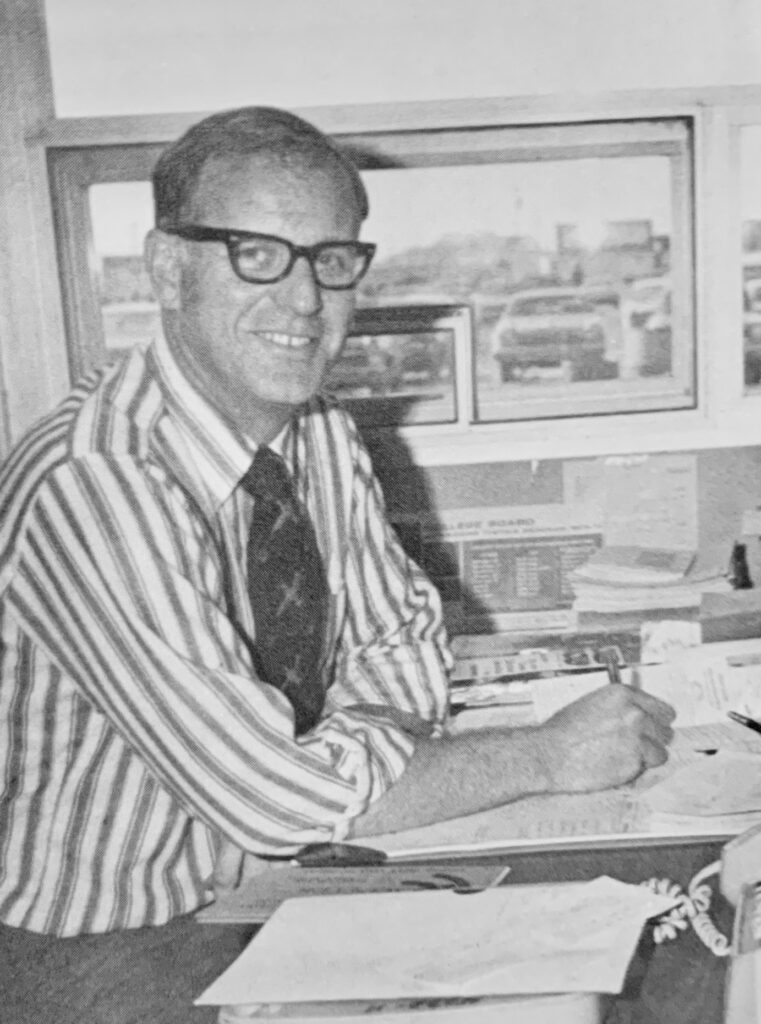
Stearns’ Hall of Fame path
The team’s induction into the BGHS Hall of Fame is meaningful to the team, but they are most excited that Coach Stearns gets the recognition he deserves.
The undefeated football team in 1973 contributed to Stearns’ induction into the BGHS Athletic Hall of Fame, but his influence went beyond one year of coaching a remarkable football season. He joined the Bowling Green High School faculty in 1960 and was an assistant football coach under Coach Paul Nester.
When Nester left Bowling Green in 1967, Stearns was named head football coach, a position he held until after the 1974 football season. He also coached basketball and track for many years and served as athletic director for eight years before returning to the classroom to round out his 32 years at the high school.
Stearns, who grew up on a farm outside of Fostoria, played offensive tackle and defensive end at Fostoria High School and then at Heidelberg College. His college football team went undefeated in his senior year, under Coach Paul Hoernemann, who had “a lot of influence on me in coaching and working with people,” Stearns said.
“He treated us as young men and he very seldom yelled,” he added.
Stearns tried to emulate many of those same qualities. “When I had to discipline someone, instead of yelling, I would go over to him, put my arm around his shoulders and talk to him individually so no one knew what was going on. But they knew I meant business,” Stearns said.
About being inducted as a coach into the BGHS Athletic Hall of Fame, Stearns said, “I think it’s a nice honor, but I have to give credit to my coaching staff because they are the ones who helped get me there. They did such an outstanding job. When you have 22 positions out there, one person can’t do it. You depend upon others and you hope your assistants do what they are supposed to do. And they did.”
He said he doesn’t miss all the work of being a coach and director of athletics, but “I miss the sidelines, walking up and down and the excitement of the game and making those decisions.”
The celebration Friday night includes a pre-game tailgate for players and coaches to reminisce and catch up, a halftime introduction of the team and coaches, and a post-game event at the Bowling Green Country Club.
“It’s going to be a good night; it will be good to reconnect with these lifelong friends and remember what we accomplished 50 years ago,” Cheetwood said.

